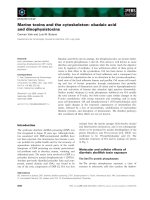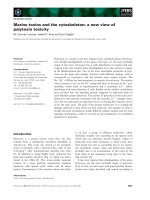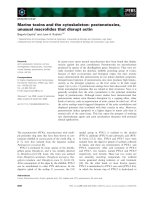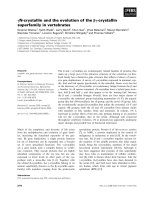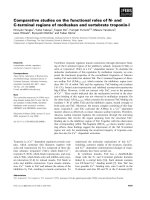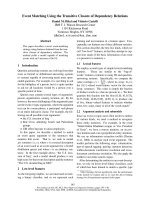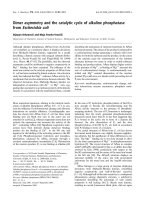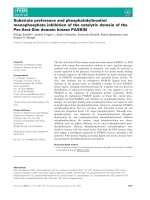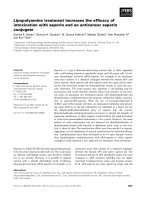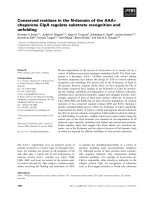Báo cáo khoa học: "Syntactic Dependence and the Computer Generation of Coherent Discourse" pdf
Bạn đang xem bản rút gọn của tài liệu. Xem và tải ngay bản đầy đủ của tài liệu tại đây (247.31 KB, 12 trang )
[
Mechanical Translation
, Vol.7, no.2, August 1963]
Syntactic Dependence and the Computer Generation
of Coherent Discourse
by Sheldon Klein and Robert F. Simmons,* System Development Corporation,
Santa Monica, California
An experiment in the computer generation of coherent discourse was
successfully conducted to test a hypothesis about the transitive nature of
syntactic dependency relations among elements of the English language.
The two primary components of the experimental computer program
consisted of a phrase structure generation grammar capable of generat-
ing grammatical nonsense, and a monitoring system which would abort
the generation process whenever it was apparent that the dependency
structure of a sentence being generated was not in harmony with the
dependency relations existing in an input source text. The final outputs
of the system were coherent paraphrases of the source text. An implica-
tion of the hypothesis is that certain types of dependency relations are
invariant under a variety of linguistic transformations. Potential applica-
tions include automatic kernelizing, question answering, automatic essay
writing, and automatic abstracting systems.
The question of the validity of transitive dependency models for
languages other than English should be explored.
Introduction
This paper sets forth the hypothesis that there is in
the English language a general principle of transitivity
of dependence among elements and describes an ex-
periment in the computer generation of coherent dis-
course that supports the hypothesis.
The hypothesis of transitive dependency, simply
stated, is that if a word or element a modifies a word b
and b modifies c, it may be said that a transitively
modifies, or is dependent on, c. Based on this principle
it was found possible to design and program a system
to generate coherent discourse using both the AN/
FSQ-32 (a large IBM military computer) and the IBM
7090. The input to the coherent discourse generator
consists of written English text which has been ana-
lyzed in terms of syntactic dependency relations. The
output is a large set of sentences generated by the
computer, each of which is a coherent paraphrase of
some portions of the input text.
We treat syntactic dependency as a primitive rela-
tion which is transitive in some environments, intransi-
tive in others. While dependency may always be transi-
tive in a system of formal logical syntax for English,
results indicate that this is not always true for a seman-
tic interpretation of that system. The totality of the
conditions under which dependency is treated as in-
transitive is subject to empirical determination by
analysis of the output of the discourse generator.
One of the components of the system is a phrase
structure generation grammar which can generate
grammatically correct nonsense. The vocabulary of a
* This research was sponsored by the Advanced Research Projects
Agency, under contract SD-97.
source text is placed in the vocabulary pool of this
program, and the generation of grammatical nonsense
is initiated.
At the same time, a monitoring program inspects
the sentence being generated and aborts the genera-
tion process whenever it is apparent that such a sen-
tence would have dependency relations incompatible
with those of the source text. The only permissible
final output is a coherent paraphrase of the source text.
From one point of view, the system functions as a
decision procedure for determining whether or not a
sentence is the result of an application of legitimate
transformations upon other sentences. The implication
is that dependency, with its transitive and intransitive
aspects, may be an invariant under many linguistic
transformations. Also, the coherent discourse generator
can be modified to act as an automatic kernelizer of
English sentences.
It is also possible to describe the operation of the
system in terms of the Stratificational Grammar of Syd-
ney Lamb
8
. By relying upon constancies of word co-
occurrence, the system provides a method of going
from the morphemic stratum of a source to the mor-
phemic stratum of an output, bypassing the sememic
stratum.
BACKGROUND
In attempting to discover a logic that would allow a
computer to answer questions from a natural English
language text
11
, we observed early that an acceptable
answer could take many forms. Words different from
those in the question would sometimes be the most
50
natural for an answer. This could be taken care of by
a thesaurus or synonym dictionary. But often, even
where all the words of the question were represented
in the answer, the syntactic structure was remarkably
different. It became apparent very quickly that in ad-
dition to the well-known fact of synonymy of different
words in English, there existed a considerable degree
of syntactic synonymy in which the same words in dif-
ferent syntactic structures could nevertheless carry
essentially the same meaning.
For example, the question “Where do large birds
live?” transforms into a bewildering complexity of
answering forms: “Living large birds are found
(where).” “Birds that are large live (where).” “Living
in (where), large birds, etc.” These examples are of
course just a few and are only those in which the
words of the question occur in the answer.
Syntactic analysis of the answers showed that there
was less variation in syntactic form than we had orig-
inally thought. But the fact that a word belonged in a
particular type of phrase in the question gave no as-
surance that the same structure would be present in
an answer. However, as we studied the syntactic trees
of the potential answers we gradually realized that
there was a relationship that appeared to be invariant.
The relative order of words on the syntactic depen-
dency tree was approximately the same in every accept-
able answer as it was in the question. Thus “Where
do birds live?” gave a tree structure in which “live” is
dependent on “birds,” “where” is dependent on “live”
and “birds” is the subject dependent upon itself. Each
of the answers maintains these dependency relationships
although there may be other words inserted at nodes on
the syntactic tree between them. For example in the
sentence “Birds that are large live (where),” “large” is
dependent on “are,” which is dependent on “that,”
which is finally dependent on “birds.” Thus, in a transi-
tive sense, “large” is dependent on “birds.”
The relative invariance of order of words on the syn-
tactic tree gave rise to the concept of transitive depen-
dency. If there exists a wholly upward path between
two words in a dependency tree, the two words are tran-
sitively dependent. As a further result of this idea, the
concept of syntactic synonymy came to have quantifiable
meaning. If two statements containing the same vo-
cabulary tokens (excepting only inflectional changes)
contain the same transitive dependencies, they are syn-
tactically synonymous.
If these two ideas are generally valid, they imply
that many operations on language hitherto impossible for
computers at once become practical. For example,
meaning-preserving transformations of the type that
Harris
5
performs, automatic essay writing, question
answering and a whole realm of difficult language pro-
cessing tasks all require (among other things) that syn-
tactic synonymy be recognized and dealt with.
To study the generality of the principle of transitive
dependency we began some programs that use this
principle for generating coherent discourse. The hypo-
thesis underlying these computer experiments may be
stated roughly as follows. Given as input a set of Eng-
lish sentences, if we hold constant the set of vocabulary
tokens and generate grammatical English statements
from that vocabulary with the additional restriction that
their transitive dependencies agree with those of the in-
put text, the resulting sentences will all be truth-preserv-
ing paraphrases derived from the original set. To the
extent that they are truth-preserving derivations, our
rules for the transitivity of dependence are supported.
In order to accomplish this experiment we borrowed
heavily from the program for generating grammatically
valid but semantically nonsensical sentences described
in detail by Yngve.
13,
14
We modified his approach by
selecting words as each part of the sentence became
defined rather than waiting until the entire pattern was
generated. In addition, we devised a system that adds
the restriction that each word selected must meet the
transitive dependency relations of the input text.
The coherent discourse generator, the dependency
rules underlying it, its outputs, its applications and
implications form the body of this paper.
Dependency
Before describing the design and operation of the co-
herent discourse generator, it is first necessary to ex-
plain the ground rules of dependency—the primitives
on which the system is based. If English were a lan-
guage in which each word necessarily modified the
following word, the dependency structure would be
immediately obvious—each word would be depend-
ent on the succeeding word. Unfortunately, English,
though highly sequential in nature, is not completely
so; in order to uncover the relation of modification or
dependency, a syntactic analysis is first necessary.
(Such dependency analysis systems as that of D. Hays
6
,
which go directly from word class to dependency links
include in their computer logic most of the rules neces-
sary to an immediate constituency analysis.) The re-
sult of a syntactic analysis is a tree structure whose
different levels include word class descriptions, phrase
names and clause designations.
The dependency analysis of these tree structures is
simply a convenient notation that emphasizes one
feature of the syntactic analysis. The feature em-
phasized is the relation of modification or dependency.
A word at any node of the dependency tree is directly
dependent on another word if and only if there is a
single line between the node of the first word and
that of the second. For our purpose the strength of
dependency notation lies in the fact that it facilitates
expression of transitive relations. The precise form
that our rules of dependency take was determined
empirically; the rules chosen were those that facilitated
the selection of answers to questions and the generation
of coherent discourse. We have attempted to state
GENERATION OF COHERENT DISCOURSE
51
those rules as generally as possible in order to allow
compatibility with a variety of syntactic analysis
systems.
The elements of a sentence in our pilot model were
taken to be words. (A more sophisticated model might
include dependency relations among morphemes.)
The rules of dependency are as follows:
1. The head of the main verb phrase of a sentence
or clause is dependent upon the head of the
subject.
2. The head of a direct object phrase is dependent
upon the head of the governing verb phrase.
3. Objects of prepositions are dependent upon
those prepositions.
4. Prepositions are dependent upon the heads of
the phrases they modify. Prepositions in the
predicate of a sentence are dependent upon the
head of a verb phrase and also upon the head
of an intervening noun phrase if one is present.
5. Determiners and adjectives are dependent upon
the head of the construction in which they
appear.
6. Adverbs are dependent upon the head of the
verb phrase in which they appear.
7. Two-way dependency exists between the head
of a phrase and any form of the verb "to be"
or the preposition “of.” This rule holds for the
heads of both phrases linked to these forms.
8. Two-way dependency within or across sentences
also exists between tokens of the same noun
and between a pronoun and its referent.
9. Dependencies within a passive sentence are
treated as if the sentence were an active con-
struction.
10. The head of the subject is dependent upon it-
self or upon a like token in a preceding sentence.
In both the computer program and the following
examples the dependencies are expressed in the form
of a list structure. The words in the text are numbered
in sequential order; where one word is dependent on
another, the address of that other word is stored with
it as follows:
0 . 0
1 John 1
2 eats 1
3 fish 2
4 . 4
A more complex example is the following:
0 . 0
1 The 2 Rule 5
2 man 2, 19, 3, 8 Rules 10, 8, 8, and 8
3 who 2 Rule 8
4 has 3 Rule 1
5 the 6 Rule 5
6 book 4, 15 Rule 2, 8
7 rode 2 Rule 1
8 his 9,2 Rules 5, 8
9 bicycle 7 Rule 2
10 in 9, 7 Rules 4, 4
11 the 12 Rule 5
12 afternoon 10 Rule 3
13 . 13
14 The 15 Rule 5
15 book 6, 17 Rules 8, 9,2
16 was
17 written 19 Rules 9, 1
18 by
19 him 19, 2 Rules 10,8
20 in 17, 15 Rules 4,4
21 two 22 Rule 5
22 hours 20 Rule 3
23 . 23
The rules for determining the antecedents of pro-
nouns across sentences are not perfect. In general it is
assumed that the referent of a pronoun occupies a
parallel syntactic function. For this purpose all sen-
tences are treated as if they were active constructions,
and special rules for case are also taken into consider-
ation. Nevertheless, the style of some writers will yield
constructions that do not fit the rules. In such cases, it
is usually only the context of the real world which re-
solves the problem for live speakers, and sometimes
not then, e.g., “The book is on the new table. It is
nice.”
THE TRANSITIVITY OF DEPENDENCE
The dependency relationships between words in Eng-
lish statements are taken as primitives for our language
processing systems. We have hypothesized that the
dependency relation is generally transitive; that is, if
a is dependent on b, and b is dependent on c, then a is
dependent on c. The purpose of the experiment with
the coherent discourse generator is to test this hypothe-
sis and to explore its limits of validity.
It was immediately obvious that if dependency were
always transitive—for example, across verbs and prepo-
sitions—the discourse generator would occasionally
construct sentences that were not truth-preserving
derivations of the input text. For example, “The man
ate soup in the summer” would allow the generation
of “The man ate summer” if transitivity were per-
mitted across the preposition. As a consequence of our
experimentation, the following rules of non-transitivity
were developed:
1. No transitivity across verbs except forms of the
verb “to be.”
2. No transitivity across prepositions except “of.”
3. No transitivity across subordinating conjunc-
tions (if, although, when, where, etc.).
There are no doubt additional exceptions and ad-
ditional convenient rules of dependency, such as the
two-way linkage that we use for “to be” and “of,”
which will improve the operation of language process-
52
KLEIN AND SIMMONS
ing systems. However, we have noticed that each spe-
cial rule eliminates some errors and causes others. The
problem is very similar to the completeness problem
for most interesting systems of formal logic (Gödel
10
)
in which the unattainable goal is to devise a system
in which all and only true theorems are derivable.
Gödel proved that one has a choice of obtaining only
true theorems but not all true theorems in the system,
or all true theorems in the system at the cost of also
obtaining false theorems.
The Generation Process
PHRASE STRUCTURE GENERATION OF
GRAMMATICAL NONSENSE
The basis for computer generation of grammatically
correct nonsense via a phrase structure generation
grammar has been available for several years. The pro-
gram design of the generation grammar used in this
system was initially modeled after one developed by
Victor Yngve
13, 14
. The recursive phrase structure form-
ulas that such a grammar uses were first crystallized
by Zellig Harris
4
in 1946. The purpose of the formulas
in Harris’s formulation, however, was to describe
utterances in terms of low-level units combining to
form higher-lex-el units. Chomsky
1
later discussed these
types of rules in application to the generation of
sentences.
The phrase structure generation grammar uses such
rules to generate lower-order units from higher-order
units. As an example, consider the following short set
of rules which are sufficient to generate an indefinitely
large number of English sentences, even though the
rules themselves account for only a very small portion
of the structure of English:
1. N
2
= Art
0
+ N
1
2. N
1
= Adj
0
+ N
1
3. N
1
= N
0
4. V
2
= V
1
+ N
2
5. V
1
= V
0
6. S = N
2
+ V
2
where “Art” stands for article, “Adj” for adjective, “N”
for noun phrase, “V” for verb phrase, “S” for sentence.
To accomplish the generation, substitution of like form
class types is permitted but with such substitution con-
trolled by subscripts. For example, the right half of
an N
1
formula or an N
2
formula could be substituted
for an N
2
, but the right half of an N
2
formula could
not be substituted for an N
1
. The use of subscripts is
not the only way to control the order of application of
formulas. It is a modification of a method used by
Yngve
13
and was suggested as one of several methods
by Harris
4
.
In the usual description of a phrase structure gen-
eration grammar, left-most entities are expanded first
and an actual English word is not substituted for
its class descriptor until the subscript of that class
marker reaches a certain minimal value.
For example:
S
N
2
+ V
2
(rule 6)
Art
0
+ N
1
+ V
2
(rule 1)
Here “Art” has a minimal subscript and one may pick
an English article at random.
The + N
1
+ V
2
The + Adj
0
+ N
1
+ V
2
(rule 2)
Another zero subscript permits a random choice of an
adjective.
The + tall + N
1
+ V
2
The tall + Adj
0
+ N
1
+ V
2
(rule 2)
Note that formula 2 might be applied recursively ad
infinitum.
The + tall + dark + N
1
+ V
2
The + tall + dark + N
0
+ V
2
(rule 3)
The + tall + dark + elephant + V
2
The + tall + dark + elephant + V
1
+ N
2
(rule 4)
The + tall + dark + elephant + V
0
+ N
2
(rule 5)
The + tall + dark + elephant + eats + N
2
The + tall + dark + elephant + eats + N
0
(rule 3)
The + tall + dark + elephant + eats + rocks
In Yngve’s program particular rules were chosen
at random, as were vocabulary items.
Agreement of number can be handled in several
ways. One could build rules that dealt with individual
morphemes rather than word classes as terminal out-
puts; one might make use of duplex sets of rules for
singular and plural constructions accompanied by sin-
gular and plural vocabulary lists; or one might have a
special routine examine the output of a generation
process and change certain forms so that they would
agree in number.
Table 1 shows a sample output of the generation
grammar which puts only grammatical restrictions on
the choice of words. All sentences are grammatically
correct according to a simple grammar, but usually
nonsensical.
THE GENERATION OF COHERENT DISCOURSE
Description of the System
The basic components of the coherent discourse genera-
tor are a phrase structure grammatical nonsense gen-
erator which generates randomly and a monitoring
system which inspects the process of sentence genera-
tion, rejecting choices which do not meet the depen-
dency restrictions.
A source text is selected and analyzed in terms of
dependency relations. In the system under discussion
this has been accomplished by hand. The vocabulary
GENERATION OF COHERENT DISCOURSE 53
TABLE 1
C
OMPUTER-GENERATED GRAMMATICAL NONSENSE
54
KLEIN AND SIMMONS
of the source text is placed in the vocabulary pool of
the phrase structure nonsense generator. The process
of generation is then initiated. Each time an English
word is selected, the monitoring system checks to see
if the implied dependency relations in the sentence
being generated match the dependency relations in
the source text. When no match is observed, the moni-
toring system either selects a new word or aborts the
process of generation and starts over.
One of the requirements for matching is that the
dependencies must refer to particular tokens of words.
For example, given a text such as:
“The man works in a store.
The man sleeps in a bed.”
if “in” is determined to be dependent on “works,” it is
only the token of “in” in the first sentence that is de-
pendent on “works.” Similarly, having selected this
particular token of “in,” it is only “store” that is depen-
dent on it. In the second sentence “bed” is dependent
on another token of “in.” Were it not for this restric-
tion it would be possible to generate sentences such as
“The man works in a bed.”
The phrase structure generator in this system dif-
fers from the type described in the preceding section
in one important way: the English vocabulary items
are chosen as soon as a class name appears, regardless
of subscript value. This permits a hierarchical selection
of English words, i.e., the heads of constructions are
selected first. Also, the generation process builds a
tree; by selecting English words immediately, the
words whose dependency relations are to be monitored
are always at adjacent nodes in the tree when the
monitoring takes place. If the English words are se-
lected at a later time the problem of determining
dependency becomes more complex, especially if the
words involved in a direct dependency relation have
become separated by other items.
For example:
S
N
2
+ V
2
N
2
+ V
2
Cats eat
Adj
0
+ N
1
+ V
2
Tall cats eat
Adj
0
+ Adj
0
+ N
1
+ V
2
Tall black cats eat
Note that “tall” is no longer adjacent to “cats.”
Adj
0
+ Adj
0
+ N
0
+ V
2
Tall black cats eat
Because the English word has already been selected, a
zero subscript means only that this item can be ex-
panded no further.
Adj
0
+ Adj
0
+ N
0
+ V
1
+ N
2
Tall black cats eat fish
Adj
0
+ Adj
0
+ N
0
+ V
0
+ N
2
Tall black cats eat fish
Adj
0
+ Adj
0
+ N
0
+ V
0
+ Adj
0
+ N
1
Tall black cats eat stale fish
etc.
Note the separation of “eat” and “fish” which are in a
dependency relation.
This example should make it clear that the monitor-
ing of dependencies is greatly facilitated if the English
words are chosen as early as possible. There is also an-
other advantage to early selection. It permits the de-
termination of heads of phrases before attributes. Note
in the preceding example that the main subject and
verb of the sentence were selected first. In a system
which generates randomly, this yields a faster com-
puter program. Consider an alternative. If one were to
start with
Adj
0
+ Adj
0
+ N
0
+ V
0
+ N
2
Tall black cats
and be unable to find a verb dependent on “cats,” the
entire sentence would have to be thrown out. Then the
computation involved in picking adjectives dependent
on “cats” would have been wasted.
Detailed Analysis of the Generation Process
The best way to explain the process of generation is to
examine a sentence actually generated by the computer,
along with its history of derivation which was also a
computer output. The experiment on which this paper
is based used as an input the following segment of text
from page 67 of Compton’s Encyclopedia
2
which was
hand analyzed in terms of dependency relations,
“Different cash crops are mixed in the general farm
systems. They include tobacco, potatoes, sugar beets,
dry beans, peanuts, rice, and sugar cane. The choice
of one or more depends upon climate, soil, mar-
ket. . . , and financing.”
The word “opportunities” occurred after market in the
original text and was deleted because it contained more
than 12 letters. This deletion results from a format
limitation of a trivial nature; it can easily be overcome
although it was not thought necessary to do so in the
pilot experiment.
The text analyzed in terms of dependency is con-
tained in Table 2. The vocabulary of the phrase struc-
ture nonsense generator, sorted according to gram-
matical category, is contained in Table 3. The grammar
rules listed in the format of their weighted probability
of selection are contained in Table 4. Each class of
rule—noun phrase rule, verb phrase rule, etc.—has ten
slots allotted to it. Probability weighting was achieved
GENERATION OF COHERENT DISCOURSE
55
by selected repetitions of various rules. Inspection of
Table 4 will show the frequency with which each rule
is represented.
Consider the generation of an actual sentence as ac-
complished by a computer. The program starts each
sentence generation with:
N
4
+ V
4
as the sentence type.
In our example,
N
4
+ V
4
Choice
a verb dependent on “choice” is now selected.
T
ABLE 2
D
EPENDENCY ANALYSIS OF SOURCE TEXT
Sequence Word Dependency
0 . 0
1 Different 3
2 cash 3
3 crops 5, 12
4 are
5 mixed 5
6 in 3, 5
7 the 10
8 general 10
9 farm 10
10 systems 6
11 . 11
12 They 3,12,34,36
13 include 12
14 tobacco 13
15 , 15
16 potatoes 13
17 , 17
18 sugar 19
19 beets 13
20 , 20
21 dry 22
22 beans 13
23 , 23
24 peanuts 13
25 , 25
26 rice 13
27 and 27
28 sugar 29
29 cane 13
30 . 30
31 The 32
32 choice 33,32
33 of 32,34,36
34 one 33,12
35 or 35
36 more 33, 12
37 depends 32
38 upon 37
39 climate 38
40 , 40
41 soil 38
42 , 42
43 market 38
44 , 44
45 and 45
46 financing 38
47 . 47
T
ABLE 3
V
OCABULARY POOL
Token Word Class
CANE
CHOICE
CLIMATE
SOIL
MARKET
FINANCING N
BEANS (noun)
PEANUTS
BEETS
CHOPS
SYSTEMS
TOBACCO
RICE
POTATOES
ARE MIXED
INCLUDE V
DEPENDS (verb)
CASH
GENERAL
FARM ADJ
DRY (adjective)
SUGAR
IN
UPON
(preposition)
THE ART
DIFFERENT (article)
N
4
+ V
4
Choice include
N
2
+ Mod
1
+ V
4
Choice include
The N
4
of the preceding step was expanded by selec-
tion of rule (3) Table 4.
N
0
+ Mod
1
+ V
4
Choice include
By selection of rule 4, Table 4. Now the Mod
1
remains
to be expanded since it is the leftmost entity with a
subscript greater than zero.
N
0
+ Prep
0
+ N
2
+ V
4
Choice include
N
0
+ Prep
0
+ N
2
+ V
4
Choice in include
“In” is dependent on choice.
N
0
+ Prep
0
+ N
2
+ V
4
Choice in systems include
“Systems” is dependent on “in.”
N
0
+ Prep
0
+ N
0
+ V
4
Choice in systems include
56
KLEIN AND SIMMONS
TABLE 4
GENERATION GRAMMAR RULES
Rule No. Formula Rule No. Formula Rule No. Formula
1 N
2
= ART
0
+ N
1
5 V
2
= V
1
+ N
2
8 MOD
1
= PREP
0
+ N
2
1 N
2
= ART
0
+ N
1
5 V
2
= V
1
+ N
2
8 MOD
1
= PREP
0
+ N
2
1 N
2
= ART
0
+ N
1
6 V
3
= V
2
+ MOD
1
8 MOD
1
= PREP
0
+ N
2
2 N
1
= ADJ
0
+ N
1
6 V
3
= V
2
+ MOD
1
8 MOD
1
= PREP
0
+ N
2
2 N
1
= ADJ
0
+ N
1
6 V
3
= V
2
+ MOD
1
8 MOD
1
= PREP
0
+ N
2
3 N
3
= N
2
+ MOD
1
7 V
1
= V
0
8 MOD
1
= PREP
0
+ N
2
3 N
3
= N
2
+ MOD
1
7 V
1
= V
0
8 MOD
1
= PREP
0
+ N
2
4 N
1
= N
0
7 V
1
= V
0
9 S
1
= N
4
+ V
4
4 N
1
= N
0
8 MOD
1
= PREP
0
+ N
2
9 S
1
= N
4
+ V
4
4 N
1
= N
0
8 MOD
1
= PREP
0
+ N
2
9 S
1
= N
4
+ V
4
5 V
2
= V
1
+ N
2
8 MOD
1
= PREP
0
+ N
2
9 S
1
= N
4
+ V
4
5 V
2
= V
1
+ N
2
9 S
1
= N
4
+ V
4
N
2
reduced to N
0
by rule (4) Table 4. The V
4
now
remains to be expanded.
N
0
+ Prep
0
+ N
0
+
Choice in systems
V
1
+ N
2
include
N
0
+ Prep
0
+ N
0
+
Choice in systems
V
1
+ N
2
include cane
“Cane” is dependent on “include”.
N
0
+ Prep
0
+ N
0
+
Choice in systems
V
0
+ N
0
include cane
And finally (two steps involved here) all zero sub-
scripts by rules 4 and 7 of Table 4.
Table 5 contains 102 sentences generated by the
coherent discourse generator using as input the ana-
lyzed paragraph (Table 2). For comparison Table 1
contains the output of the same system, except for the
dependency monitoring routine.
Comments on Linguistic Methodology of the Program
The grammar used in the pilot model of this program
is an extremely simple one. The parts of speech (Table
3) include only article, noun, verb, adjective, and
preposition. The grammatical rules used are a tiny
subset of those necessary to account for all of English.
Accordingly, the hand analysis of the vocabulary into
parts of speech required a number of forced choices.
Namely, “different” was classified as an article, and
“farm” and “sugar” were classified as adjectives. A
larger grammar including several adjective classes
would permit more adequate classification.
An interesting strategy has been developed for the
handling of intransitive verbs. As noted above, the sys-
tem does not distinguish between transitive and in-
transitive verbs. The running program demands that an
attempt be made to find a direct or indirect object for
every verb. Only if no such object is found to be de-
pendent on the verb in the source text is the generation
of a verb with no object permitted. In effect, a bit of
linguistic analysis involving the source text is done at
the time of generation.
A system to automatically perform dependency
analysis on unedited text is currently being developed.
Part of it (a system which performs a phrase structure
analysis of English text) is completely programmed
and operative on the IBM 7090. A system for convert-
ing the phrase structure analysis into a dependency
analysis is currently being programmed.
Theoretical Discussion
What is the significance of the transitivity of depend-
ency? Granted, our rules for manipulating dependency
to generate coherent discourse can be viewed as a
clever engineering technique. However, we feel that
the transitive nature of dependency is of greater theo-
retical significance. A language is a model of reality.
To the extent that it is a good model, its speakers are
able to manipulate it in order to draw valid inferences
about reality. The rules of dependency are part of a
model of language, a model which is in turn a second-
order model of reality. The value of any model is de-
termined by the truth of its predictions. In this case
the value of our transitive dependency model is deter-
mined by the validity of the output of the coherent
discourse generator in terms of its input.
If we have uncovered some of the mechanisms in-
volved in the logical syntax of English,* then depend-
ency is a primitive for our model of that system, and
the rules about its transitivity and intransitivity are
axioms. Whether or not concepts of transitive depend-
ency might be important components in logical-syn-
tactic models of other languages can be tested easily.
*
We have made no attempt to deal with conditionals or negation
in the present experiment.
GENERATION OF COHERENT DISCOURSE
57
TABLE 5
COMPUTER-GENERATED COHERENT DISCOURSE
58
KLEIN AND SIMMONS
One has only to conduct new experiments in the gene-
ration of coherent discourse.
Our coherent discourse generation experiment has
interesting implications for transformational theory
5, 1
.
The experiment involved control of co-occurrence; that
is, the vocabulary of the output was limited to the
vocabulary of the source text. It was demanded that
pertinent transitive or intransitive dependency rela-
tions be held constant from source to output. The fact
that the output sentences of Table 5 look like a set that
might have been derived from the source text (page
56) by a series of truth-preserving transformations,
suggests that dependency, in its transitive and intransi-
tive aspects, is an invariant under a large number of
transformations.
Also of great importance is the fact that these sen-
tences were produced without the use of a list of
transformations.* The implication here is that the co-
herent discourse generator contains a decision proce-
dure for determining whether a sentence could have
been derived from source text by an appropriate choice
of transformations.
One might also note in passing that an automatic
kernelizer would not be a difficult application of the
principles involved. What is necessary is to adjust the
sentence pattern rules of the coherent discourse gen-
erator so that only kernel type sentences can be gen-
erated. Inspection of Table 5 will reveal that a number
of kernels derived from the source text have indeed
been generated.
With respect to the Stratificational Theory of
Language as propounded by Sydney Lamb
8
, our rules
of transitive dependency permit the isolation of syn-
tactic synonymy. It would seem that given control
over co-occurrence of morphemes and control over syn-
tactic synonymy, one has control over remaining
sememic co-occurrence. This would suggest that our
rules provide a decision procedure for determining the
co-occurrence of sememes between one discourse and
another, without need for recourse to elaborate dic-
tionaries of sememes and sememic rules.
Potential Applications
The principles of transitive dependency and of syntac-
tic synonymy lend themselves very readily to a num-
ber of useful language processing applications. Among
these are the recognition of answers to questions, a com-
puter essay writing system, and some improvements in
automatic abstracting.
QUESTION ANSWERING
Given an English question and a set of statements
some of which include answers and some of which do
*
One transformation, however, was used implicitly, in that pas-
sive construction dependencies were determined as if the construction
had been converted to an active one.
not, the dependency logic is very helpful in eliminating
statements which are not answers. The logic involved
is similar to that used in the part of the coherent dis-
course generator which rejects sentences whose de-
pendency relations are not in harmony with those in a
source text. In the case of a question answering sys-
tem, the question is treated as the source text. Instead
of generating sentences for comparison of dependencies,
a question answering system would inspect statements
offered to it as potential answers, and reject those with
dependencies whose inconsistencies with those of the
question fall above a minimum threshold.
The primary set of potential answers might be se-
lected through statistical criteria which would insure
presence of terms which also occurred in the question.
This set would then be subjected to analysis by a
dependency comparison system. Such an approach is
used in the protosynthex question answering system
which is currently being programmed, and is partly
operative on the IBM 7090.
7, 11, 12
For an example of this application, consider the
question in Table 6 and some potential answers. Each
of the potential answering sentences was selected to
contain almost all of the words in the question. In the
first potential answer, Answer 1, “cash” is dependent
on “crops”; “are” is equivalent to “include” and is de-
pendent on “crops”; “bean” is dependent on “are”; and
“soy” is dependent on “bean.” Thus the potential
answer matches the question in every dependency link
and, for this type of question, can be known to be an
answer. The second example, Answer 2, also matches
the question on every dependency pair and is also an
answer.
In Answer 3, the importance of some of the rules
which limit transitivity can be seen. For example,
transitivity across a verb is not allowed. Thus “beans”
is dependent on “eat” which is dependent on “people”
which is dependent on “includes.” Because “eat” is a
verb, the dependency chain is broken and the match
with the question fails. In a similar manner “cash” in
the same sentence would be transitively dependent on
“crops” via “bring,” “to,” and “fails” except that the
chain breaks at “bring.” In Answer 3, every dependency
link of the question fails and the statement can un-
equivocally be rejected as a possible answer even
though it contains all the words of the question.
In general, for question answering purposes, the
matching of dependencies between question and
answer results in a score. The higher this score value
the greater the probability that the statement contains
an answer.
AUTOMATIC ESSAY WRITING
A system to generate essays on a computer might make
use of a question answering system and a coherent dis-
course generator. The input to such a system would be
a detailed outline of some subject. Each topic in the
GENERATION OF COHERENT DISCOURSE
59
TABLE 6
D
EPENDENCIES OF A QUESTION
AND SOME ANSWERS
Q
UESTION
Sequence Dependency
1 Do
2 cash 3
3 crops 3
4 include 3
5 soy 6
6 beans 4
ANSWER 1
Sequence Dependency
1 Soy 2
2 beans 2,3
3 are 2,6,7
4 a 6
5 cash 6
6 crop 3
7 in 6,3
8 the 9
9 South 7
A
NSWER 2
Sequence Dependency
1 Cash 2
2 crops 2
3 include 2
4 peanuts 3
5 and 5
6 soy 7
7 beans 3
A
NSWER 3
Sequence Dependency
1 The 2
2 state 2
3 includes 2
4 people 3,5
5 who 4
6 eat 5
7 soy 8
8 beans 6
9 when 6
10 the 12
11 peanut 12
12 crop 9
13 fails 12
14 to 13
15 bring 14
16 a 18
17 cash 18
18 return 15
outline would then be treated as if it were a retrieval
question. This would mean that statements pertinent
to the outline topic would be retrieved from a reference
corpus. The vocabulary of the retrieved statements
would then be placed in the vocabulary pool of the
coherent discourse generator. Those words which were
common to both the outline topic and the retrieved
statements might be weighted so as to maximize the
probability of their occurrence in the sentences that
would be generated.
After a number of paraphrases had been produced,
the one or ones which had the maximum number of
words in common with those in the outline topic would
be printed out as the computer-generated expansion for
that topic. The process would continue for all the topics
in the outline. The output would then be some form
of essay—an essay with fuzzy transitions between
ideas and perhaps occasional irrelevancies, but never-
theless a computer-generated essay.
AUTOMATED ABSTRACTING
A procedure similar to the one outlined for the com-
puter production of essays might be expected to offer
considerable improvement over the present state of
automatic abstracting or extracting as discussed by
Luhn
9
and Edmundson
3
and others. One approach
might take a set of the most pertinent typical words
represented in the article as estimated by frequency
counting techniques and use a coherent discourse gen-
erator to construct a set of sentences, each of which
included a maximal set of those words. The same
process would be followed on the words which had
not yet been built into sentences, until the list of words
was exhausted. Since only dependencies present in the
original article would be allowed, the resulting ab-
stracted paraphrase could not deviate from the rela-
tionships set up by the author.
Another approach might impress on each article a
frame of words pertinent to a particular literature
searcher. For example, a chemist looking at an article
would be interested in those statements that included
chemical terms and chemical relationships. A physician
looking at the same article would be interested in a
medical vocabulary. By extracting from the article those
words which matched the vocabulary of a particular
discipline and weaving these into a set of sentences,
we would expect to construct meaningful, specialized
abstracts.
Summary and Conclusions
In this paper, the hypothesis that the dependency re-
lationship between words is largely transitive has been
supported by an experiment in producing coherent dis-
course on a computer. The experiment showed that
dependency is not always a transitive relationship;
some significant exceptions include the lack of transi-
tivity across verbs, prepositions and many subordinat-
ing conjunctions. If these exceptions were ignored, the
discourse generator could produce statements that
were not truth-preserving derivations from the original
text.
The rules of dependency and transitivity of de-
pendence may be considered as the beginnings of a
60
KLEIN AND SIMMONS
transitive dependency model of English. Experiment
has supported this model to the extent that the use of
such rules allows a computer to automatically generate
coherent discourse. Other experiments in answering
questions, generating essays and automatic abstracts
have been planned and begun in order to further de-
velop the model and to continue testing the hypothesis
of transitive dependencies.
The question of the validity of transitive depend-
ency models for other languages needs also to be con-
sidered. Since the technique for dependency analysis
originated in Europe and is currently finding use on at
least one French language project and several efforts
at Russian translation, it is reasonable to suspect that
transitivity is as important in these languages as it ap-
pears to be for English. An important linguistic question
whose answer depends on many more experiments is
“To what extent is transitive dependency a feature of
the logical syntax of all human languages?”
Received October 8, 1962
References
1.
Chomsky, N. Syntactic Structures.
’s-Gravenhage: Mouton and Co.,
1957.
2.
Compton’s Encyclopedia—F. E.
Compton & Co., Chicago, Vol. 1,
1962.
3.
Edmundson, H. P., Oswald, V. A.,
Jr., and Wyllys, R. E. Automatic
Indexing and Abstracting of the
Contents of Documents, PRC-126
ASTIA AD No. 231606. Los
Angeles: Planning Research Cor-
poration, 1959.
4.
Harris, Zellig. From Morpheme
to Utterance.
Language,
Vol. 22,
pp. 161-183, 1946.
5.
Harris, Zellig. Co-occurrence and
Transformation in Linguistic
Structure.
Language,
Vol. 33,
No. 3, pp. 283-340, 1957.
6.
Hays, D. G. Studies in Machine
Translation—10: Russian Sen-
tence-Structure Determination,
RM-2538. The RAND Corpora-
tion, 1960.
7.
Klein, S., and Simmons, R. F. A
Computational Approach to Gram-
matical Coding of English Words.
SDC document SP-701. 25 pp.,
February 22, 1962.
8.
Lamb, Sydney M. Outline of
Stratificational Grammar. Univer-
sity of California, Berkeley, 1962.
(mimeo)
9.
Luhn, H. P. The Automatic Cre-
ation of Literature Abstracts.
IBM Journal of Research and De-
velopment,
Vol. 2(2), pp. 159-
165, 1958.
10.
Nagel, E. and Newman, J. R.
Gödel’s Proof. New York Univer-
sity Press, 1958.
11.
Simmons, R. F., Klein, S., and
McConlogue, K. Toward the Syn-
thesis of Human Language Be-
havior.
Behavioral Science,
Vol.
7, No. 3, pp. 402-407, 1962.
12.
Simmons, R. F., and McConlogue,
K. Maximum-depth Indexing for
Computer Retrieval of English
Language Data. SDC document
SP-775. 22 pp., 1962.
American
Documentation
(in press), Janu-
ary 1963.
13.
Yngve, Victor H. A Model and
an Hypothesis for Language
Structure.
Proceedings of the
American Philosophical Society,
Vol. 104, No. 5, pp. 444-466,
1960.
14.
Yngve, Victor H. Random Gen-
eration of English Sentences.
Pro-
ceedings of the 1961 Conference
on Machine Translation of Lan-
guages and Applied Language
Analysis,
National Physical Lab-
oratory Symposium No. 13, pp.
66-80, 1962.
GENERATION OF COHERENT DISCOURSE
61
